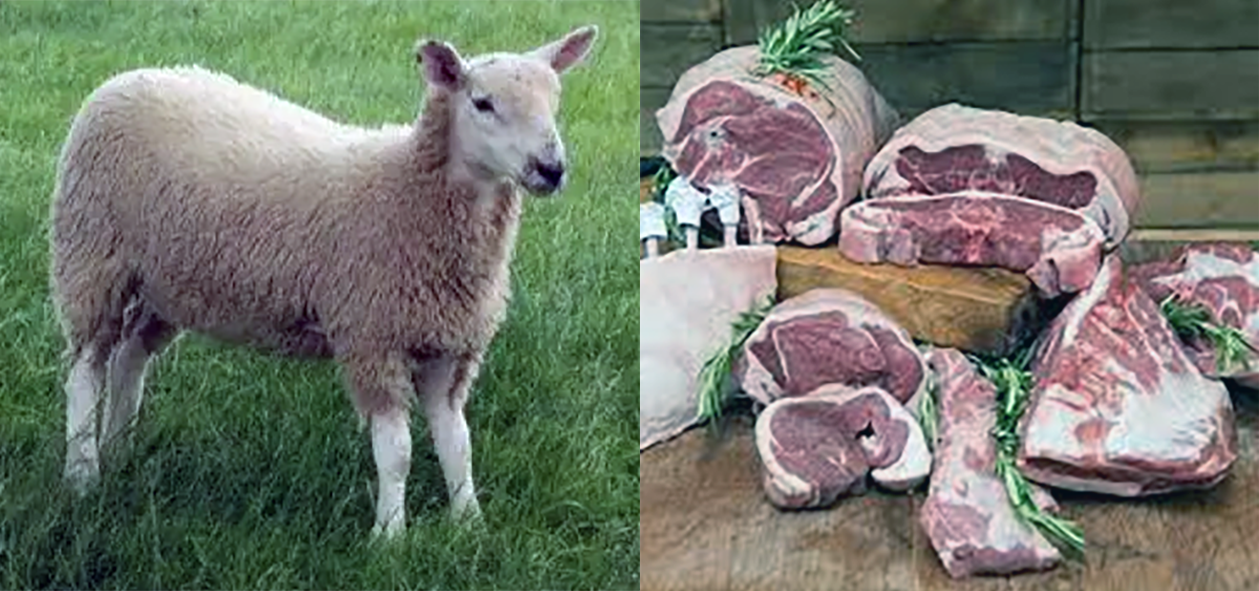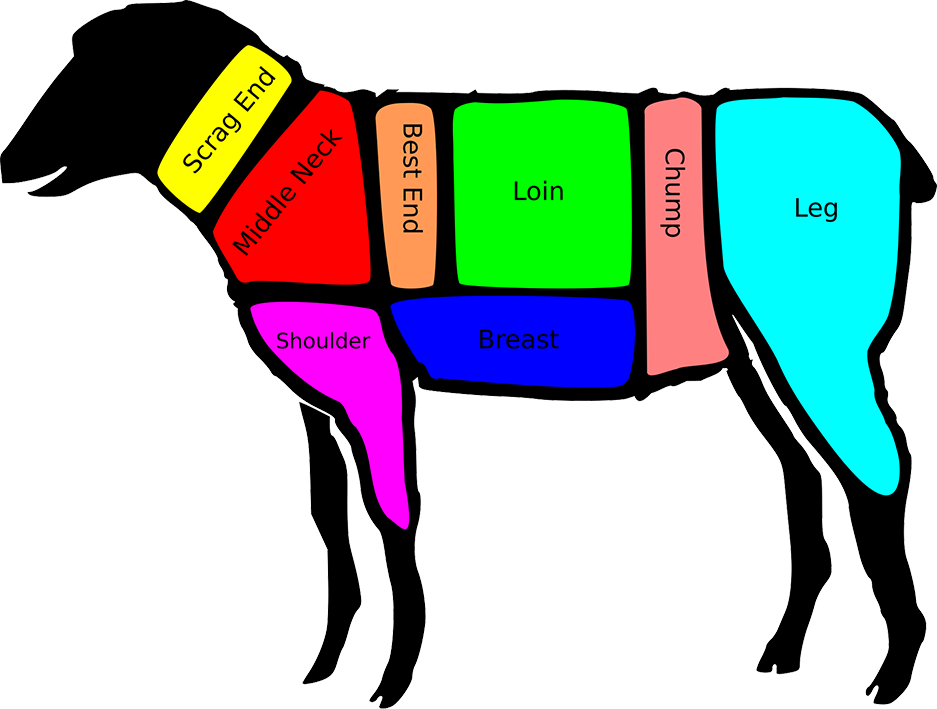FabulousFusionFood's Lamb-based Recipes 2nd Page
 Mature lamb and a selection of lamb cuts.
Mature lamb and a selection of lamb cuts.
Welcome to FabulousFusionFood's Lamb-based Recipes Page — The recipes presented here are all based on cow meat. Lamb represents a young sheep (Ovis aries) which is less than one year old.
Hogget is term for a sheep of either sex having no more than two permanent incisors in wear, or its meat. In the UK, it means animals that are 11 to 24 months old. Still common in farming usage and among speciality butchers, it is now a rare term in British, Australian and New Zealand supermarkets, where meat of all sheep less than two years old tends to be called 'lamb'.
Other types of lamb are as follows:
Suckling lamb or milk-fed lamb — meat from an unweaned lamb, typically 4–6 weeks old and weighing 5.5–8 kg. This is typically generally unavailable in the UK but can be sourced from speciality butchers and farm shops.
Young lamb — a milk-fed lamb between six and eight weeks old
Spring lamb — a lamb, usually three to five months old, born in late winter or early spring and sold usually before 1 July (in the northern hemisphere).
Yearling lamb — a young sheep between 12 and 24 months old
Salt marsh lamb (also known as 'saltmarsh lamb' or by its French name, agneau de pré-salé) is the meat of sheep which graze on salt marsh in coastal estuaries that are washed by the tides and support a range of salt-tolerant grasses and herbs, such as samphire, sparta grass, sorrel and sea lavender.
The meat of a lamb is taken from the animal between one month and one year old, with a carcass weight of between 5.5 and 30 kg (12 and 66 lb). This meat generally is more tender than that from older sheep and appears more often on tables in some Western countries.
Sheep are most likely descended from the wild mouflon of Europe and Asia, with Iran being a geographic envelope of the domestication centre. One of the earliest animals to be domesticated for agricultural purposes, sheep are raised for fleeces, meat (lamb, hogget or mutton), and milk. A sheep's wool is the most widely used animal fibre, and is usually harvested by shearing. In Commonwealth countries, ovine meat is called lamb when from younger animals and mutton when from older ones; in the United States, meat from both older and younger animals is usually called lamb. Sheep continue to be important for wool and meat today, and are also occasionally raised for pelts, as dairy animals, or as model organisms for science.
Sheep meat and milk were one of the earliest staple proteins consumed by human civilization after the transition from hunting and gathering to agriculture. Sheep meat prepared for food is known as either mutton or lamb, and approximately 540 million sheep are slaughtered each year for meat worldwide. "Mutton" is derived from the Old French moton, which was the word for sheep used by the Anglo-Norman rulers of much of the British Isles in the Middle Ages. This became the name for sheep meat in English, while the Old English word sceap was kept for the live animal. Throughout modern history, "mutton" has been limited to the meat of mature sheep usually at least two years of age; "lamb" is used for that of immature sheep less than a year.
Cuts of Lamb (UK, Canada, and other Commonwealth countries):
 Cuts of Lamb:
Cuts of Lamb:Scrag end (of neck) — stewing
Middle neck — braising, stewing
Best End (of neck) — roasting, stewing, braising
Loin (including chops, racks and saddle) — roasting, frying, braising
Chump (and chump chops) — frying
Barnsley chop, a large double loin chop — frying
Leg (gigot in Scotland) including leg steaks — roasting, frying
Shank — braising
Shoulder — roasting Breast — braising
Offal — typically tongue, liver, heart, stomach, sweetbreads, testicles, intestines and kidneys
The alphabetical list of all the lamb-based recipes on this site follows, (limited to 100 recipes per page). There are 507 recipes in total:
Page 2 of 6
| Chorba Frik (Green Wheat Soup) Origin: Tunisia | Dundee Lamb Chops Origin: Scotland | Harira Bidaouia Origin: Morocco |
| Chorbah (Lamb and Vegetable Soup with Vermicelli) Origin: Tunisia | Easter Greek Lamb Origin: Greece | Harira Mauritanienne (Mauritanian Harira) Origin: Mauritania |
| Christmas Island Beriani Origin: Christmas Island | Easter Lamb Bobotie Origin: South Africa | Harissa Lamb Noodles Origin: Fusion |
| Chulitas de Cordero (Spanish Lamb Cutlets) Origin: Spain | Easter Leg of Lamb with Apricots Origin: Britain | Highveld Lamb Curry Origin: South Africa |
| Cig Oen â Saws Llus (Lamb with Bilberry Sauce) Origin: Welsh | Elaichi Gosht (Lamb With Cardamom) Origin: India | Hlalem (Pasta with Beans) Origin: Tunisia |
| Cig oen bys a bawd gyda saws bara lawr (Lamb Finger Food with Laverbread Sauce) Origin: Welsh | Elleniké arnié aiga Paschast (Greek Easter Lamb or Kid) Origin: Greece | Home-made Gyros Origin: Greece |
| Cig Oen Cymreig â Mêl (Honeyed Welsh Lamb) Origin: Welsh | Extumer Lamb Roast Origin: Germany | Hægeldaðir lambalæri (Slow-cooked Lamb Shanks) Origin: Iceland |
| Cig Oen Cymreig Gyda Saws Mafon (Welsh Lamb with Raspberry Sauce) Origin: Welsh | Ffagod Cig Oen (Welsh Lamb Faggots) Origin: Welsh | In ficato oenogarum (Livers of Animals Fattened on Figs, Another Way) Origin: Roman |
| Cig Oen gyda Saws Bara Lawr Llysieuog (Lamb with Herby Laverbread Sauce) Origin: Welsh | Fonnell Origin: England | In ficato oenogarum (Wine Sauce for the Livers of Animals Fattened on Figs) Origin: Roman |
| Cig Oen Gyda Stwffin a Saws Bricyll (Stuffed Lamb with Apricot Sauce) Origin: Welsh | Forshmak (Georgian Minced Meat Soufflé) Origin: Georgia | Indian Koftas Origin: Fusion |
| Cig Oen Mewn Mêl a Seidr (Lamb in Honey and Cider) Origin: Welsh | Fragrant Lamb Kofta Curry Origin: Britain | Indian Takeaway Style Seekh Kebabs Origin: Britain |
| Cig Oen Rhost (Roast Lamb) Origin: Welsh | Fried Lamb's Kidneys with Guinness and Mushroom Sauce Origin: Ireland | Iraqi Dolma Origin: Iraq |
| Çişlik (Shashlyk) Origin: Turkmenistan | Goan Lamb Xacutti Origin: India | Irish Lamb and Potato Curry Origin: Ireland |
| Coes Oen gyda Rhosmari a Mwstad (Roast Leg of Lamb with Rosemary and Mustard) Origin: Welsh | Golwythion Cig Oen gyda Rhosmari ac Afal (Lamb Chops with Rosemary and Apples) Origin: Welsh | Irish Lamb Stew Origin: Ireland |
| Colombo d'Agneau à la Mauricienne (Mauritian-style Colombo of Lamb) Origin: Mauritius | Golwythion Cig oen wedi Llenwi (Stuffed Noisettes of Lamb) Origin: Welsh | Irish Lamb Stew Origin: Ireland |
| Colombo de Martinique Origin: Martinique | Golwython Oen Cymreig (Welsh Lamb Chops) Origin: Welsh | Irish Stew Origin: Ireland |
| Colonial Goose Origin: Ireland | Golwython Oen Mewn Saws Seidr (Lamb Cutlets in a Cider Sauce) Origin: Welsh | Irish Stock Origin: Ireland |
| Copadia Haedina Sive Agnina (Choice Cuts of Kid or Lamb) Origin: Roman | Gorkhali Lamb Curry (Nepalese Lamb Curry) Origin: Nepal | Isicia Omentata (Roman Burgers) Origin: Roman |
| County Cork Irish Stew Origin: Ireland | Gormeh Sabzi (Persian Lamb and Herb Stew) Origin: Iran | Jerk Kebabs Origin: Jamaica |
| Couscous de Timbuktu Origin: Mali | Green Bean Bredie Origin: South Africa | Jerk Lamb Chops Origin: Cayman Islands |
| Crockpot Curry Hotpot Origin: Fusion | Green Pea and Liver Curry Origin: Sri Lanka | Kadhai Gosht Origin: Pakistan |
| Crown Roast of Lamb Origin: Britain | Guard of Honour Origin: Britain | Kafta with Argan Oil (Syrian Meatballs with Argan Oil) Origin: Syria |
| Curried Gluten-free Lamb Cobbler Origin: Britain | Haedum sive Agnum Parthicum (Parthian Kid or Lamb) Origin: Roman | Kale mamoe saka (Lamb Flaps Curry) Origin: Samoa |
| Curried Lamb Chops Origin: Fusion | Haedus sive Agnum Tarpeianum (Kid or Lamb à la Tarpeius) Origin: Roman | Kalia (Meat and Potato Curry) Origin: Bangladesh |
| Curry d'Agneau (Comoran Lamb Curry) Origin: Comoros | Haedus sive Agnus Crudus (Seasoning for Raw Kid or Lamb) Origin: Roman | Kansiyé Origin: Guinea |
| Cyri Cig Oen a Chennin (Welsh Lamb and Leek curry) Origin: Welsh | Haedus sive Agnus Syringiatus (Boned Suckling Kid or Lamb) Origin: Roman | Kazakh Shashlik Origin: Kazakhstan |
| Cyri Oen Cymreig (Welsh Lamb Curry) Origin: Welsh | Haenau Cig Oen gyda Pannas a Chennin (Slices of Lamb with Parsnips and Leeks) Origin: Welsh | Kazakiye Riz (Kazkah Rice) Origin: Kazakhstan |
| Düğün Çorbası (Wedding Soup) Origin: Turkey | Haggis Origin: Scotland | Kebbe Blaban (Kebbe in Yoghurt Sauce) Origin: Lebanon |
| Damaa Origin: Sudan | Haggis Balls with Mustard-whisky Sauce Origin: Scotland | Keema Curry Origin: Pakistan |
| Devilled Kidneys Origin: Britain | Hairst Bree (Harvest Broth) Origin: Scotland | Keema Mattar Origin: India |
| Dibi Origin: Gambia | Hara Mircha (Bell Pepper Curry) Origin: India | Keema Naan Origin: India |
| Dolma (Stuffed Grape Leaves) Origin: Azerbaijan | Harees Origin: UAE | Keleya Zaara (Tunisian Lamb with Saffron) Origin: Tunisia |
| Domoda II Origin: Gambia | Harees Origin: Oman | |
| Dovga (Pea and Sorrel Soup with Meatballs) Origin: Azerbaijan | Harees Origin: Bahrain |
Page 2 of 6